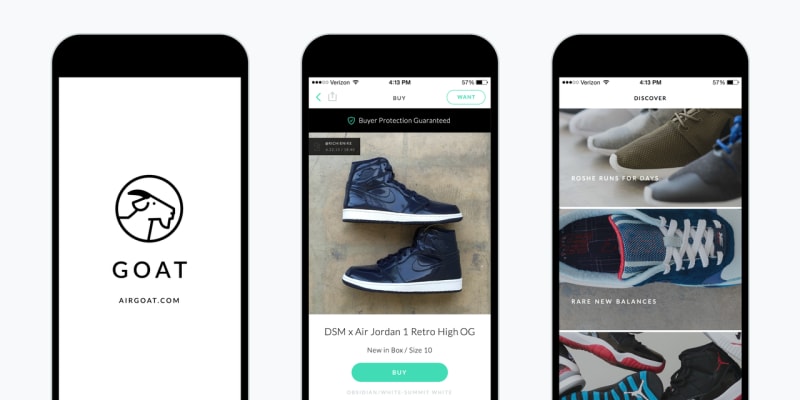
There was a magical time, long, long ago, where you’d walk into a sneaker store, look at the product on the shelves, ask for your size, and walk out with a new pair of shoes. Those days, for the most part, have come and gone.
Nearly every anticipated sneaker release today takes place online—long lines and campouts are increasingly becoming a thing of the past. But even standard online sneaker drops, where a retailer would make the product available on its website and wait for it to sell out, are starting to become antiquated, too. In the past two years, brands and stores have started to introduce release custom apps designed to better serve those trying to sneakers and avoid having their websites crash—prospective buyers just need to download, register, and login to get the sneakers they want. We’ve seen it happen with Adidas and Yeezys through the Confirmed app, and Nike has its own SNKRS app meant to streamline your latest pickup. Retailers, such as Ronnie Fieg’s Kith, have teamed up with Shopify and its Frenzy app to release high-demand shoes. But are these apps actually achieving their purpose—making it easier to buy shoes? The results are mixed.
When Adidas rolled out the Confirmed app with the launch of the Adidas Yeezy 750 Boost in February 2015, it was a failure. The app crashed for many users, who had to be in a certain geographic zone to get a chance to buy the shoes. The brand has since worked on the app and has received less criticism. Nike also unveiled its app SNKRS right around the same time—it was widely seen as having a had better user experience. And Shopify, the company that takes care of ecommerce retailers’ backends, has recently created Frenzy, which was designed to give people a better chance of procuring hyped footwear and streetwear.
“We saw this opportunity, because at Shopify our goal is to make commerce more fair for everyone. Customers weren’t having the best experience when shopping online. Sneakers might drop at 11 in the morning. It didn’t make sense for people to have to run to their computers in order to purchase these products,” says Tucker Schreiber, a product manager at Shopify, about the company’s Frenzy app. “Now we have the technology where we can build a mobile app that places the releases in everyone’s pockets, and everyone profits. The goal with Frenzy is to reduce the amount of friction that consumers and retailers face when they do these sneaker drops.”

The recent surge of apps has sought to make buying sneakers online more fair. Previously, retailers would often get hacked by bots, or savvy consumers would find their way into the shop’s backend and buy up the stock before everyone else got a chance. Frenzy is an iOS-based product that uses Apple Pay to verify that actual people are buying the sneakers—not bots who unfairly reserve sneakers through automated add-to-cart services.
“We want to replicate the experience that people have waiting in front of a store when they’re shopping online. Our goal is to make it as seamless and quick as possible for consumers to know if they’ve taken a W or an L,” Schreiber says. “The one thing that we’re really confident that we continue to say about Frenzy is that it hasn’t been bot-ed yet. We have a team of app security engineers that are looking for bugs in the system that would allow them do that. Frenzy is strong enough and secure that if you’re trying to purchase Yeezys on Frenzy, you have a better chance of getting them than if you were trying to get them on a regular online store.”
But some consumers aren’t happy with this new era of sneaker drops. Many complain about the location-based aspect of the some of the apps and long for the days of buying shoes through a standard waiting-in-line process. “I live in a suburb of Philadelphia, and I had to drive about 40 minutes to get within the Confirmed ‘zone’” for Adidas’ app, says 33-year-old Anthony Racaniello, marketing director at Philadelphia sneaker boutique Lapstone & Hammer. “I posted up in a Starbucks and tried to get the shoes, and I didn’t get them. It took up a good part of my day, and I still look the L. If I had gotten the shoes, I would have felt good about it. As an adult man, it’s embarrassing.”
Frenzy has also dabbled in area-sensitive sneaker releases, teaming up up with Montreal’s Off The Hook to do a geo-specific release of the Adidas Yeezy Boosts a couple months ago. These sort of releases aren’t just giving Shopify the chance to better serve its consumers—they also double as an opportunity to gather new information for the next hyped shoe on the horizon. “We just did a release in Montreal with a boutique called Off The Hook with our new technology called Drop Zone, a geo-sensor where people need to be standing in an area to purchase the shoes,” Schreiber says. “We’re working closely with brands like Kith and Off The Hook and seeing how they want sneaker drops to work, and we’re gathering as much information as we can from them [and] consumers to make the experience as fair for everybody.”
While these sort of releases are giving a select group of consumers a more even chance of getting the shoes, some people say that the apps are mostly being used by brands to build up hype around sneakers that are lacking it. “Brands having an app and releasing [product] through the app is part of the marketing—there’s a perception that the shoe will be hard to get, or you have to wait your turn in a virtual line.” Racaniello says. “I think the brands are toying with that. In Adidas’ case, I think they actually have that energy. What Nike throws up on its SNKRS app, is for no reason. You might see the same thing at Finish Line two weeks later. It’s a two-way street: Brands will continue release sneakers through their apps, but the brands building up hype behind shoes through their apps might fade.”
Release date apps aren’t the only sneaker software that’s popped up as a means to obtain shoes lately, though. There are also reselling apps that look to simplify the process and make it easier and safer for everyone involved. GOAT launched in 2015, received $5 million in funding last year, and looks at itself as an alternative to buying and selling shoes on eBay.

“Before us, sneaker enthusiasts had to sift through hundreds of listings on eBay and other platforms for the same exact product–some listing photos had carpet stains, while others had fries and a burger in the background. These aren't exactly things you want to see when purchasing a pair of fresh kicks,” says Sen Sugano, who works as Head of Marketing and Communications for GOAT. “After sifting, reviewing sellers and prices, you make your purchase. But then you have to worry about the seller shipping, and once you get them, verifying they are actually authentic and what was promised in the listing.”
Sugano boasts that GOAT has over one million active users per month, and he says that the app has made reselling a more seamless process from your mobile phone. “It's much easier because you can sell on the go. We send push notifications and updates, so you can easily adjust prices, accept offers from buyers and even manage logistics from your mobile device, wherever you are,” he says.
The rise of reselling apps goes hand-in-hand with the proliferation of release date apps, and it’s possible that someone is buying sneakers through Frenzy and then posting them for sale on GOAT within a matter of minutes. “For big releases, sellers are looking to move their inventory quickly. Our mobile app gives sellers the ability to list and manage sales as soon as they get the sneakers. With the recent Yeezy Boost 350 V2 'Cream White' release, sellers were listing from the retail shops as [soon as] they got their sneakers,” Sugano says. “Without a mobile app, they would have to wait to reach a computer to list or use a mobile web application, which isn't as great of an experience.”
Meanwhile, Frenzy is working on a way to ensure that people who have struck out over and over on sneakers will get first dibs on the next hot release. “We’re saying, ‘OK, you’ve taken an L 30 times in a row on Frenzy—let’s see how we can bump you up to be the first person to take advantage of the next sale,’” says Schreiber, who reveals that Frenzy is working on Android version of the app.
The frustration behind using some of the apps has led some to try and bring the sneaker-buying experience back to an earlier, more-transparent time. “I don’t know if the apps are making it easier or more difficult to get sneakers, but they’re making it a more frustrating experience,” says Racaniello, who’s helping implement his ideas around sneakers releases at the retailer that he works for. “We try really, really hard so people don’t have to jump through hoops. We try to be really transparent with typical raffles. We try to verify people through social media handles to make sure they’re real people and not bots. We want to get the sneakers to people who really want them. It’s important to us that we keep it as simple as possible.”
It’s still up for debate whether release date apps are making it easier for the Average Joe to buy sneakers, but this was bound to happen sooner or later: When more people want the product than there are units available, there’s always going to be pandemonium over it, whether it’s an iPhone or pair of shoes. The way people buy the latter, however, is rapidly changing, whether consumers like it or not.
Related: Best Android Apps

